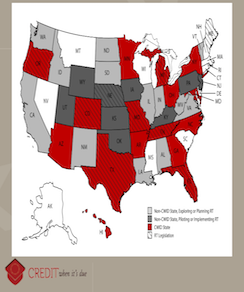On June 8-9, the 16 Credit When It’s Due (CWID) grantees convened in Indianapolis, Indiana to reflect on key issues facing states with the implementation of reverse transfer degrees and to discuss sustainability for these efforts. Twenty-three additional states and representatives from several national organizations joined the convening to engage in this discussion and mine the lessons learned.
This blog highlights a few take-aways from the CWID convening and shares links to key resources and materials from the convening. The convening offered an opportunity for the CWID states to share lessons learned among the other grantees and the non-CWID states.
1. The CWID grant has impacts beyond reverse transfer. It was evident during the convening and through OCCRL’s research that reverse transfer implementation efforts brought to the surface many existing inefficiencies in the transfer process that reach beyond reverse transfer. For example, the technology infrastructure to exchange student transcript data and audit degrees is often inadequate and outdated. Similarly, course articulation tables and equivalencies are sometimes nonexistent or not maintained in many institutions. Reverse transfer has prompted discussions about and investments in updated technologies and enhanced course equivalency and articulation tables.
2. Reverse transfer needs to be integrated into existing systems and student pathways. Several attendees observed that reverse transfer is a promising strategy that needs to be integrated into existing systems and existing student pathways. This prompts questions about the optimal time for students to transfer (before or after receiving the associate’s degree) and how states and institutions can ensure reverse transfer is not simply an afterthought but an intentional and integrated marker of students’ educational pathways.
3. Reverse transfer policies are elevating questions about the value of the associate’s degree. Which students should receive an associate’s degree? Traditionally, students enrolled at a university are pursuing a bachelor’s degree, not an associate’s degree. Reverse transfer policies challenge this dominant tradition, particularly for the 40% of transfer students who do not earn a bachelor’s degree within four years of transfer. It was clear through the convening and through OCCRL research that not all stakeholders understand the value of the associate’s degree. Reverse transfer policies and programs have led to new discussions about the value of the associate’s degree among the general public, students, policymakers, and university and community college leaders and staff.
4. As of June 2015, more than 7000 reverse transfer credentials were conferred by eleven CWID states. The number of reverse transfer credentials conferred among the CWID states grew from 3000 in March 2014 to over 7000 in eleven states by June 2015. Several states are still developing and investing in technology that will enable automation and scaling, so this number continues to grow as many states are not yet implementing reverse transfer at scale.
5. Interest in reverse transfer is growing. Reverse transfer programs and policies are in their infancy, and the national interest in reverse transfer was shown by the 38 states that attended the event. Among the 23 non-CWID states in attendance, approximately half indicated they were piloting or implementing reverse transfer, and the other half indicated they were exploring or planning reverse transfer.
The states that were funded by CWID to develop and implement reverse transfer have generated a wealth of research and practical information. OCCRL collected and aggregated convening resources on the CWID website. At this website, you can find links to the convening agenda, CWID state profiles that provide details about reverse transfer policies, OCCRL’s research presentation, presentations by the National Student Clearinghouse and the Missouri Reverse Transfer, OCCRL research papers and briefs, and much more.
Jason L. Taylor is an assistant professor in the Department of Educational Leadership and Policy at the University of Utah. He received his PhD in higher education from the University of Illinois at Urbana-Champaign with a research specialization in evaluation methods and concentration in public policy. His broad research interests are at the intersection of community college and higher education policy and educational and social inequality. Dr. Taylor has conducted and led several quantitative and mixed methods studies related to college readiness, developmental education, adult pathways to college, dual credit/enrollment and early college experiences, transfer policy and reverse transfer, LGBTQ students and educational access and equity. He is currently the Co-PI with Dr. Debra Bragg and co-leading the research agenda for the Credit When It’s Due initiative, a 15-state effort to develop and implement reverse transfer programs and policies.
